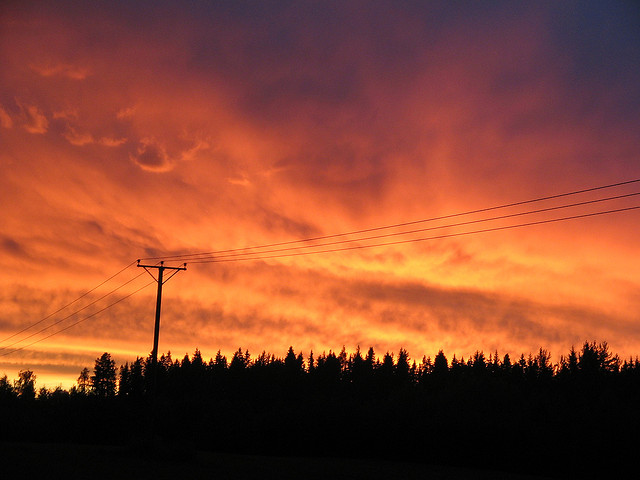Podcast: Play in new window | Download
Subscribe: RSS

A new DOE report says everything in the energy sector, from power lines to refineries, is under attack from global climate change. (Photo by MNSC/Flickr
If you want a good scare this weekend, forget about seeing Pacific Rim: curl up with the latest report from the US Department of Energy. It is truly terrifying. All the more so because it comes from a government department long regarded as a cheerleader for Big Oil, Big Coal and Big Power. Now, however, this report on the vulnerabilities of the entire US energy sector to climate change puts them all — and us — on notice: the energy infrastructure of the United States and the world is now under relentless attack for which it is not prepared; the attacks not only are going to continue, but are going to increase in frequency and severity, for the foreseeable future. The enemy is climate change.
The thesis is even more remarkable when you reflect that the DOE is funded by a Congress 47 per cent of whose members and 75 per cent of whose leaders declare they do not “believe in” climate change. Here’s how the report begins:
“Since the start of the 20th century, average annual temperatures across the contiguous United States have increased approximately 1.5°F. Recent weather conditions are no exception to this trend. July 2012 was the hottest month in the United States since record keeping began in 1895, and 2012 was the warmest year overall, marked by historic high temperatures and droughts, above average wildfires, multiple intense storms that disrupted power to millions, and multiple extreme heat waves. More than 60% of the country experienced drought during the summer of 2012, including some areas of exceptional drought. These trends, which are expected to continue, could restrict the supply of secure, sustainable, and affordable energy critical to the nation’s economic growth.”
By “economic growth,” of course, they mean survival (more on weasel words later). The report is blistering in its honesty about what has already happened, and what is likely to happen. Consider a partial list of events that occurred just in the last year (the report includes ten years of these events):
-
February 2013: Over 660,000 customers lost power across eight states in the Northeast affected by a winter storm bringing snow, heavy winds, and coastal flooding to the region and resulting in significant damage to the electric transmission system.
-
October 2012: Ports and power plants in the Northeast, as well as oil refineries, fuel pipelines, and petroleum terminals, were either damaged or experienced shutdowns as a result of Hurricane Sandy. More than 8 million customers lost power in 21 affected states.
-
August 2012: Oil production in the U.S. Gulf of Mexico declined and coastal refineries shut down in anticipation of Hurricane Isaac. Although the closures were precautionary, offshore oil output was reduced by more than 13 million barrels over an 18-day period, and offshore Gulf natural gas output was curtailed by 28 billion cubic feet.
-
August 2012: Dominion Resources’ Millstone Nuclear Power Station in Connecticut shut down one reactor because the temperature of the intake cooling water, withdrawn from the Long Island Sound, was too high and exceeded technical specifications of the reactor. Water temperatures were the warmest since operations began in 1970. While no power outages were reported, the two-week shutdown resulted in the loss of 255,000 megawatt-hours of power, worth several million dollars.
-
July 2012: Four coal-fired power plants and four nuclear power plants in Illinois requested permission to exceed their permitted water temperature discharge levels because the temperature of their cooling water pond is regulated to prevent adverse ecological impacts. The Illinois Environmental Protection Agency granted special exceptions to the eight power plants, allowing them to discharge water that was hotter than allowed by federal Clean Water Act permits.
-
July 2012: In the midst of one of the worst droughts in American history, certain companies that extract natural gas and oil via hydraulic fracturing faced higher water costs or were denied access to water for 6 weeks or more in several states, including Kansas, Texas, Pennsylvania, and North Dakota.
-
June 2012: Almost three million people and businesses lost power due to the complexes of thunderstorms coupled with strong winds, also known as a derecho, that swept across the Midwest to the Mid-Atlantic coast. In addition, damage to water filtration facilities in Maryland caused the imposition of water restrictions.
-
Summer 2012: Drought and low river water depths disrupted the transportation of commodities, such as petroleum and coal, delivered by barges. The U.S. Army Corps of Engineers reported grounding of traffic along the Mississippi River.
-
Summer 2012: Reduced snowpack in the mountains of the Sierra Nevada limited California’s hydroelectric power generation capacity by about 8%, or 1,137 megawatts.
There are plenty of weasel words in the report, of course. For example, it avers that there are good things about climate change, as well. How many? Two. What are they? I swear I am not making this up. Good Thing Number One is that in some places, winters will be warmer, and thus require less energy for heat. [In other places, of course, winters will be colder; the idea that everyplace is getting uniformly warmer is uninformed.] Good Thing Number Two? We might get more oil out of an ice free Arctic Ocean.
But it’s not hard to see through the weasel words and see, clearly visualized in this report from our government, a grim dystopian future that is advancing rapidly on us, for which no one is ready or getting ready.
Great article; thanks!